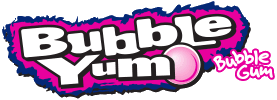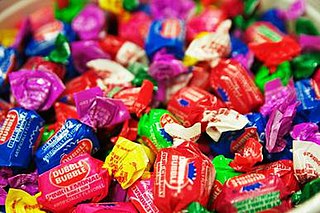Related Research Articles

Bubble gum is a type of chewing gum, designed to be inflated out of the mouth as a bubble.

Chewing gum is a soft, cohesive substance designed to be chewed without being swallowed. Modern chewing gum is composed of gum base, sweeteners, softeners/plasticizers, flavors, colors, and, typically, a hard or powdered polyol coating. Its texture is reminiscent of rubber because of the physical-chemical properties of its polymer, plasticizer, and resin components, which contribute to its elastic-plastic, sticky, chewy characteristics.

The Topps Company, Inc. is an American company that manufactures trading cards and other collectibles. Formerly based in New York City, Topps is best known as a leading producer of baseball and other sports and non-sports themed trading cards. Topps also produces cards under the brand names Allen & Ginter and Bowman.

The Fleer Corporation, founded by Frank H. Fleer in 1885, was the first company to successfully manufacture bubble gum; it remained a family-owned enterprise until 1989.

Juicy Fruit is an American brand of chewing gum made by the Wrigley Company, a U.S. company that since 2008 has been a subsidiary of the privately held Mars, Incorporated. It was introduced in 1893, and in the 21st century the brand name is recognized by 99 percent of Americans, with total sales in 2002 of 153 million units.

The Wm. Wrigley Jr. Company, known as the Wrigley Company, is an American multinational chewing gum company, based in the Global Innovation Center (GIC) in Goose Island, Chicago, Illinois.

Mentos are a brand of packaged scotch mints or mint-flavored candies sold in stores and vending machines. First produced in 1932, they are currently sold in more than 130 countries worldwide by the Italian-Dutch corporation Perfetti Van Melle. The mints are small, tiny oblate spheroids, with a slightly hard exterior and a soft, chewy interior.
Hubba Bubba is a brand of bubble gum produced by Wm. Wrigley Jr. Company, a subsidiary of Mars, Incorporated. Introduced in the United States in 1979, the bubble gum got its name from the phrase "Hubba Hubba", which some military personnel in World War II used to express approval. The main gimmick used to promote the gum is that, as Hubba Bubba is less sticky than other brands of gum, it is easier to peel off the skin after a bubble bursts. When Hubba Bubba was first marketed, the gum's flavor was similar to that of others but, over time, different flavors have been produced.

Bubble Yum is a brand of bubble gum marketed by The Hershey Company. Introduced in 1975 by Life Savers, the bubble gum was the first soft bubble gum created. It was created by a homemaker in Fisk, Missouri, who named it "rubber bubblegum". She gave some to her son to pass out at school. She soon sold the recipe to the Life Savers candy division in St. Louis.

Big League Chew is an American brand of bubble gum that was created by Portland Mavericks left-handed pitcher Rob Nelson and bat boy and future film-maker Todd Field. It was then pitched to the Wrigley Company by fellow Maverick and former New York Yankee All-Star Jim Bouton as a healthy imitation of the tobacco-chewing habit common among ballplayers in the 1970s. Over 800 million pouches of Big League Chew have been sold since 1980. Big League Chew was introduced in May 1980, in the traditional pink color already seen in established brands of bubble gum. The cartoon-style packaging, originally designed by artist Bill Mayer, comes in colors such as neon green and bright purple (grape). The original shredded R&D concept samples of the product were produced by running standard sheets of bubble gum through an office paper shredder.

Chiclets is an American brand of candy-coated chewing gum manufactured by Mondelez International. The brand was introduced in 1900 by the American Chicle Company, a company founded by Thomas Adams.

Dubble Bubble is an American brand of fruit-flavored, usually pink-colored, bubble gum invented by Walter Diemer, an accountant at Philadelphia-based Fleer Chewing Gum Company in 1928. One of Diemer's hobbies was concocting recipes for chewing gum based on the original Fleer ingredients. Though founder Frank H. Fleer had come up with his own bubble gum recipe under the name Blibber-Blubber in 1906, it was shelved due to its being too sticky and breaking apart too easily. It would be another 20 years until Diemer would use the original idea as inspiration for his invention.
Walter E. Diemer was an American accountant who, in 1928, invented bubble gum.

The Philadelphia Chewing Gum Corporation was a Pennsylvania corporation formed on August 12, 1947, to manufacture candy, chewing gum, and specialty confectionery products. The company was also notable for its American Football Cards when in 1964 the company signed a deal with the NFL.
Gum base is the non-nutritive, non-digestible, water-insoluble masticatory delivery system used to carry sweeteners, flavors, and any other substances in chewing gum and bubble gum. It provides all the basic textural and masticatory properties of gum.
Two multi-national companies, Wrigley and Cadbury, together account for some 60% market share of the worldwide chewing gum market. The global market shares for the top five chewing gum companies are estimated to be:
Frank Henry Fleer was an American confectioner who is thought to have developed the first bubble gum. Fleer founded the Frank H. Fleer Corporation in 1919 as a gum manufacturer. Fleer's original formulation, called Blibber-Blubber, was never marketed to the public. It was not until 1928 that Walter Diemer, an accountant in Fleer's company, was able to refine the formulation and became marketed by Fleer's company as Dubble Bubble.

5 is a brand of sugar-free chewing gum that is manufactured by the Wrigley Company, marketed toward teenagers. The name "5" hints at the five human senses and that it has 5 calories.

Chicle is a natural gum traditionally used in making chewing gum and other products. It is collected from several species of Mesoamerican trees in the genus Manilkara, including M. zapota, M. chicle, M. staminodella, and M. bidentata.
References
- ↑ Nix, Elizabeth. "Chew on This: The History of Gum". History. A&E Television Networks. Retrieved July 26, 2015.
- ↑ Miller, Frederic P.; Vandome, Agnes F.; McBrewster, John (August 2011). Blibber-Blubber. International Book Marketing Service Limited. ISBN 978-613-5-63429-7.
- ↑ "Bubble gum enjoyment is firmly embedded lifestyle". Index-Journal. May 27, 1980. Retrieved February 19, 2021.
- ↑ Shuster, Gary (2006). From Manila to the Monkey Trial. Lulu.com. p. 83. ISBN 9781411684225.
- ↑ "WALTER DIEMER, INVENTOR OF BUBBLE GUM IN 1920S". Chicago Tribune. January 13, 1998. Retrieved May 22, 2023.
- ↑ "Walter Diemer Level 1". Pennsylvania People. Retrieved May 17, 2022.
- ↑ Wild, Wolfgang (November 21, 2018). "Bubble gum: Black and white photos show the hilarious history". www.considerable.com. Archived from the original on March 3, 2020. Retrieved March 3, 2020.